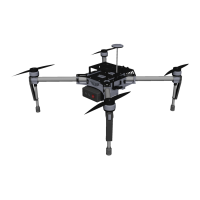©
2015 DJI. All Rights Reserved.
53
Flight
Once pre-ight preparation is complete, it is recommended to use the ight simulator to learn how to
y safely. Ensure that all ights are carried out in an open area.
Flight Environment
1. Do not use the aircraft in adverse weather conditions including raining, snowing, fog, and wind
speeds exceeding 10 m/s.
2. Only y in open areas. Tall buildings and steel structures may affect the accuracy of the compass
and the GPS signal.
3. Avoid ying near obstacles, crowds, high voltage power lines, trees and bodies of water.
4. Avoid ying in area with high levels of electromagnetism, including mobile phone base stations and
radio transmission towers.
5. Aircraft and battery performance is subject to environment factor such as air density and
temperature. Be very careful when ying over 14700 feet (4500 meters) above sea level as the
battery and aircraft performance may be reduced.
6. The M100 cannot operate in P-Mode within the Earth’s polar regions.
Flight Limits and No Fly Zones
Flight limits on height and distance can be set.
Unmanned aerial vehicle (UAV) operators should abide by the regulations from self-regulatory
organizations such as the ICAO (International Civil Aviation Organization), the FAA and their local
aviation authorities. For safety reasons, flight limits are enabled by default to help users use this
product safely and legally.
When operating in P-Mode, the height limit, distance limit and No Fly Zones work together to monitor
ight. In A-Mode, only the height limit prevents the aircraft from going above 120 meters.
Maximum Height and Radius Limits
Users can change the maximum height and radius limits in the DJI Pilot app. Once complete, your
M100 will y in a restricted cylinder that is determined by these settings. The tables below show the
details of these limits.
Max Height
Max Radius
Home Point
Height of aircraft
when powered on

